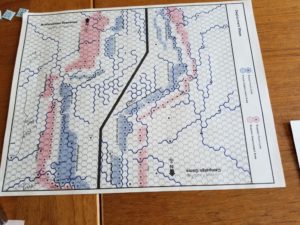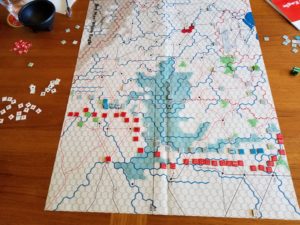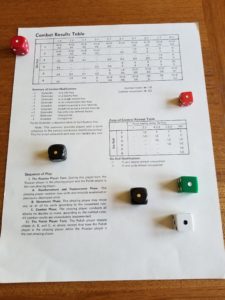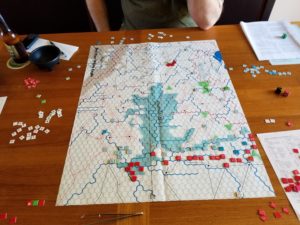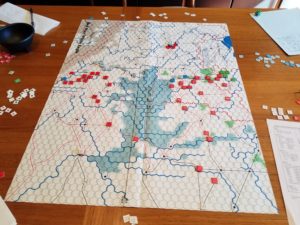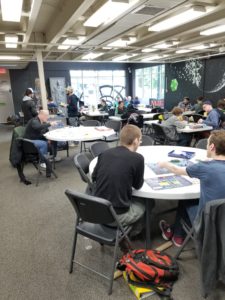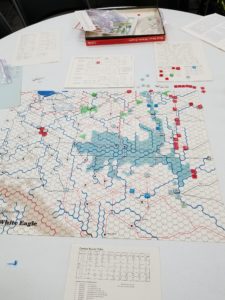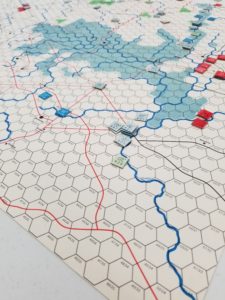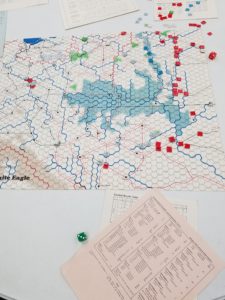Back to Portland for a long-awaited replay of the new version of Red Star/White Eagle (RSWE). This Deluxe Edition is published by Compass Games.
Tim and I played the old GDW version several times (follow the tag) and always enjoyed it, despite some serious rules screw ups. We started playing the new version back in early February, but ran afoul of the Super Bowl and some accompanying wackiness.
The Compass edition of this classic Polish-Soviet War game is improved in every way, with a better map, thicker and larger counters (too large for our tweezers), as well as very functional set-up and reinforcement displays. These displays, combined with counters that include campaign set up designations, really help the set-up.
One aspect that hasn’t changed is the very bloody Combat Results Table (CRT). The CRT also allows the attacker to advance multiple hexes after combat. With good die rolls, an aggressive attacker can generate plenty of operational movement with opportunities for deep and wide envelopments.
But, these envelopments must be judiciously evaluated, since they also provide an opponent with opportunities to sever exposed supply lines or cutoff extended units.
Another game element that hasn’t changed, and one that significantly effects (maybe “shapes” would be a better term) play is how zones of control (ZOC) are treated. In RSWE, passing through the ZOCs costs additional movement points. The exact costs are shown on the unit’s counter. Also, enemy ZOCs cut supply lines, and the presence of friendly units doesn’t offset the effects of enemy ZOCs.
The attractive and functional map is divided into Soviet South and Southwest Fronts. The central area is heavily wooded, while the topography to each side is both sides is open, but with river barriers, especially in the South Front. Soviet units must remain in their respective fronts, and cannot be transferred from one front to another.
The game abstracts concurrent Soviet operations against White Russian forces. The primary tool for this is a mandatory “stand down” for the South Front units. During this stand down, these units cannot attack Polish forces unless Polish attacks occur, and then, only on a one-for-one basis. There are also mandatory unit withdrawals representing other developments during the Russian Civil War.
April IV (1920) the first of the weekly campaign turns. The Soviet player conducts his reinforcement/replacements, movement and combat first (except for the April IV turn!).
The Polish player has the initiative for the first few turns. The Soviet player must initially cover each hex along both fronts with either a unit or a ZOC; a very real Thin Red Line. The Poles set up last and can pick and choose where to attack. This creates several opportunities, especially around Kiev in the Southwest. Taking Kiev produces victory points as well as Ukrainian reinforcements. But any advance beyond Kiev faces a flood of Soviet replacements and reinforcements.
The management and placement of these replacements (within their assigned Front) is a critical aspect of the game, allowing the Soviet player to not only stabilize the Southwest Front, but also counterattack, especially after the arrival of the First Cavalry Army (Konarmia).
Replacements arrive as generic units placed either on the map, to rebuild reduced (divisions and some brigades have full strength and reduced combat values) units, or held off map to recreate eliminated units during the next turn.
Here is a quick visual summary of our game.
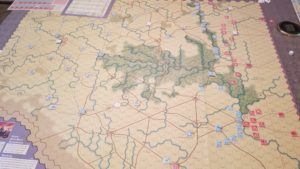
The Poles are in Kiev (lower right hand corner), with the Soviets cobbling together a cordon defense.
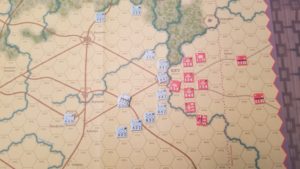
Armored trains cannot be rebuilt and are kept out of harm’s way until they can be productively used.
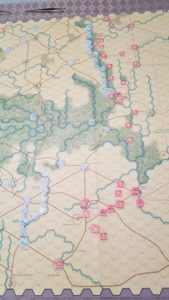
The Poles have pulled back from Kiev, anticipating the arrival of the First Cavalry Army.
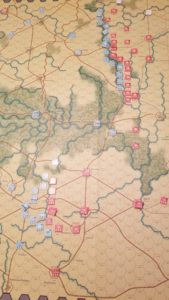
Fighting now taking place along the river lines. The Soviet player now has the First Cavalry Army on the map.
A big meal and a tendency to bullshit led to an early end of play. A rematch is scheduled for the second week in June.
